Spinal diseases every year become younger.One of the most common remains of osteochondrose, which was only recently considered exclusively with the disease related to age.If it affects the spine of the cervix, rather strong pain in the neck, arms and heads, can occur, significantly reducing the quality of life.This often monitors other disorders and if not beautiful, leads to the formation of intervertebral kilas, whose large quantities require surgical intervention.Therefore, it is important to diagnose cervical osteochondrose, which is possible for earlier and start treatment according to the situation.

Symptoms of osteochondrose cervix
Osteochondrosis of cervix is a disease in which degenerative changes in the interfaced discs appear.Initially, discs that are cartilage rings containing iron content, become dehydrated.It is most often the result of a seated lifestyle, prolonged work on your computer, bad posture, door injuries and numerous other factors.
This leads to a decrease in the power of collagenic fibers that make up an Annulus Fibrosus disk.As a result, his thickness is gradually declining, which becomes the main reason for the development of symptoms characteristic of cervical osteochondrosis:
- pain in the neck of different degrees of intensity;
- Headaches, dizziness, loss of consciousness caused by a violation of cervical vertebrae passing directly through vertebrae, I.E.Development of vertebral syndrome;
- Fluctuations in blood pressure levels;
- Radical syndrome, caused by pinching the spinal roots, which is accompanied by irradiating the pain from the door to hand, to hand and fingers, heads, shoulders, sensory disorders in these areas, in relatives, etc.;
- reduction of neck movement, appearance or intensification of pain when performing certain movements;
- Increased fatigue, reduced performance;
- Tinnitus, reduced vision sharpness, development of ENT pathologies that are difficult to treat.
There are 7 vertebral in the vertebrae.Most often, osteochondrosis affects discs that are between 5. And 6., like 6th. And 7. vertebrae.
In such situations, you must contact a neurologist who prescribes MRI.The results of this test allow precisely to identify osteochondrose in any, even the earliest stage of development and choice of treatment.
Development phases
Generally, there are 4 stages of osteochondrose development:
- 1. Grade - Pathological changes are just beginning to appear on the intervertebral disk, so the symptoms are mild and only occasionally are observed.In such situations, treatment will be as efficient and simpler as possible.
- 2. The degree - changes in discs become more pronounced, which leads to the appearance of painful neck pain, which occurs and amplifies when performing the head movement.
- 3. The class - the pain becomes almost constant and can be complicated in the development of vertebrae syndrome, as well as the formation of protrusion and intervertebral hernia.
- The fourth degree - disk is so destroyed that the possibility of movement in the affected segment of the spinal movement almost completely excluded.In this case, strong pain is observed, radical syndrome is often developed, and one or both vertebrates are stabbed, which leads to the appearance of characteristic symptoms.
Cervical osteochondrose treatment
Thus, tactics treatment for cervical osteochondrosis depend on the severity of degenerative changes in interfaced discs, patient's age and its individual characteristics.Therefore, it is always developed separately for each patient, but it is always focused on solving the following problems:
- Elimination of unpleasant symptoms that worsen the patient's quality of life;
- Improving the quality of blood circulation in the neck;
- Improving metabolic processes in the affected area;
- Eliminating the causes of degenerative dystrophic changes in interfaced discs;
- Reduction of risks of development of osteochondrose complications, IE.Bumps, intervertebral pounds, spondylosis, etc.
In general, at each stage of disease development indicates the use of different therapeutic measures.If in the first phase, it will be enough to adapt to your way of life and engage in the exercise therapy, and in the second phase, an extensive, including orthopedic devices, using orthopedic devices, etc. in the second phase, using orthopedic devices, etc.
But patients must understand that it is impossible to achieve the reverse regression of degenerative-dystrophilic changes that have already occurred, especially if diagnosed phase 2 or more osteochondorosis.In such situations, treatment will be focused on improving the patient's well-being and stop further advancement of the disease.Sometimes it is possible to completely correct the situation in 1. phase of osteochondrose, but at this stage of development, pathology is diagnosed extremely rarely, because patients experience lower neck discomfort and not counseling with the doctor.
In severe cases, the treatment of osteochondrose of the cervical spine will be even more complex and longer.In any case, it is carried out under the supervision of neurologists with periodic accompanying examinations and adapting therapy depending on changes in the patient's welfare.
Correction of lifestyle
All patients diagnosed with cervical osteohondroises are advised to change certainly into their lifestyle.In any case, these recommendations vary depending on the characteristics of a person's professional activity and more.
The vast majority is advised to increase the level of physical activity and rest from work for at least every hour to warm if it involves seating.In cases where the patient is actively involved in sports, it is recommended that it reduces the load on the grlic spine.Therefore, it will be shown to give up starting, jumping sports, weight lifting and wrestling.
People who are excess weight are additionally recommended to take measures to reduce as well as adjust their diet.When Osteochondrosis has already occurred, it is important that the diet meets the daily body needs as completely possible.It is therefore worth giving up fast food and semi-finished products and approximation of diet rational.This means that it is worth creating the menu so that half a diet consists of vegetables and fruits, and contains a sufficient amount of protein.
Treatment of cervical osteochondorosis medicines
Medicine therapy is mainly focused on removing unpleasant symptoms of osteochondrose cervaries of the spine.As a rule, it is complex and involves the use of drugs from different groups, each solves specific problems.Therefore, it develops and separately for each patient.
Nsaids
Non-steroidal anti-inflammatory drugs or NSAIDs are a wide group of drugs that do not have not only flammable, but also analgesic properties.They are available in various forms of dosing, including pills, capsules, fats, gels and creams, as well as solutions for intramuscular use.NSAIDs should only be used on request, I.E.When strong neck pain appears.
For strong pain, NSAIDs can be applied intramuscularly.
The lack of oral drugs from the NSAID group is their irritating effect on the mucous membrane of the stomach and duodenum.This can cause to deteriorate the flow of diseases of these organs, especially gastritis and peptic ulcers.In order to reduce such risks, prototon pump inhibitors are prescribed in combination with them.
There are medicines that have a mild effect on the gastrointestinal tract, which are widely prescribed for pain relief and inflammation in osteochondrose.Also, more advanced medications have already been developed, characterized by selective performance that are often prescribed for osteochondrose, but are more expensive and are not available to all patients.
Corticosteroids and injections (blockage)
Corticosteroids are hormonal medications prescribed by patients with severe inflammatory processes.They can cause many undesirable consequences with long-term use, therefore they are prescribed in short courses in the most difficult cases.As a rule, the use of injection solutions is stated, because with this method of administration, these medications are much easier to tolerate in the body and is less likely to cause side effects.
Corticosteroids are often used in combination with local anesthetics when performing blockades, ie to quickly mitigate very strong pain by introducing prepared mixtures in special points near the transition of spinal nerves.The procedure requires certain skills and dexterity, and therefore may be carried out only in medical institutions in particularly trained medical workers.By the way, the probability of developing undesirable consequences and complications is very large.
Recommended blockages no.From 4 times a year.
Muscular relaxants
Muscular relaxants are a group of drugs used to remove cramps from the reflex muscle caused by an acute inflammatory process.This often happens with cervix osteochondrose and causes strong neck pain, which further worsens the situation.
Vitamins
Since osteochondrosis creates significant prerequisites for the compression of spinal roots, it is often indicated to take vitamin complexes that contain primarily B vitamins.They are directly involved in the transmission of nerve pulses, which are particularly important in the development of radical syndrome.
Chondroprotectors
Chondroprotectors are a drug around which a lot of controversies seize.They are based on substances that the body uses to return damaged cartilage tissue that determines the indications for their use in cervical osteochondrosis.But at the same time there is no convincing evidence of their efficiency in advanced forms of disease.In the early stages of osteochondrose, they actually have a positive effect on the state of interviolent discs, leading to improving the patient's welfare.And in later phases, they can only help to inhibit further advancement of degenerative changes in interfaced discs.
Chondroprotectors are produced in the form of powder for preparation of solutions, capsules, point of use, as well as solutions for intramuscular use.The biggest positive effect was seen from the latter.
Topicl products
These are precisely medications, available in the form of gel, cream, or fat, that patients often begin to use when signs of cervical osteochondorosis occur.They have different effects, including anti-inflammatory, analgesic, warming, or, vice versa, cooling and local irritant.
Often these products contain NSAIDs, so they help reduce pain, but are effective mainly in the early stages of osteochondrose.Also, the components of such drugs can be menthol, extract with hot plants, snakes or bees poison.
Local irritators operate on the principle of irritation of nerve skin endings, which occurs reduction in pain and increased blood flow in the application area.But such drugs are in effect only in the initial stages of the development of cervical osteochondrose.
Preparations for microcirculation improvement
Medications in this group are used to improve the quality of blood circulation, which is especially necessary for vertebral syndrome.Numerous medications have a vasolishing effect, which improves brain nutrition and helps to remove tinnatus, headaches and dizziness.But without an effective elimination of a factor that puts pressure on the spine artery, such treatment will only provide temporary results.
Practice therapy
Physical therapy is the basis for the treatment of osteochondrose of the cervical spine.Today, there are many different ownership and generally accepted methods of exercising cervical therapy, but patients should understand that there are no universal exercises.The specialist must choose a specialist in a single basis, taking into account the not only phase of degenerative dystrophic changes, but also the age of the patient, the nature of existing syndrome or vertebral compression.Therefore, different exercises may be listed for the same patients with approximately the same changes in interfaced discs.
Generally, physical therapy has the following goals:
- Strengthening muscle neck neck and upper shoulders;
- activating blood circulation in the affected area, which will contribute to the reconstruction of the fibrous rings of intervertebral disks;
- Normalization of muscle tone.
It is necessary to do exercise therapy every day.Initially, it is best to attend special groups or work with an exercise instructor individually.This will allow you to master the master's degree in the technique of performing each proposed exercise so that its application brings maximum benefit.The specialist will help you select the optimal load and develop a program to increase it, taking into account the patient's level of physical development.
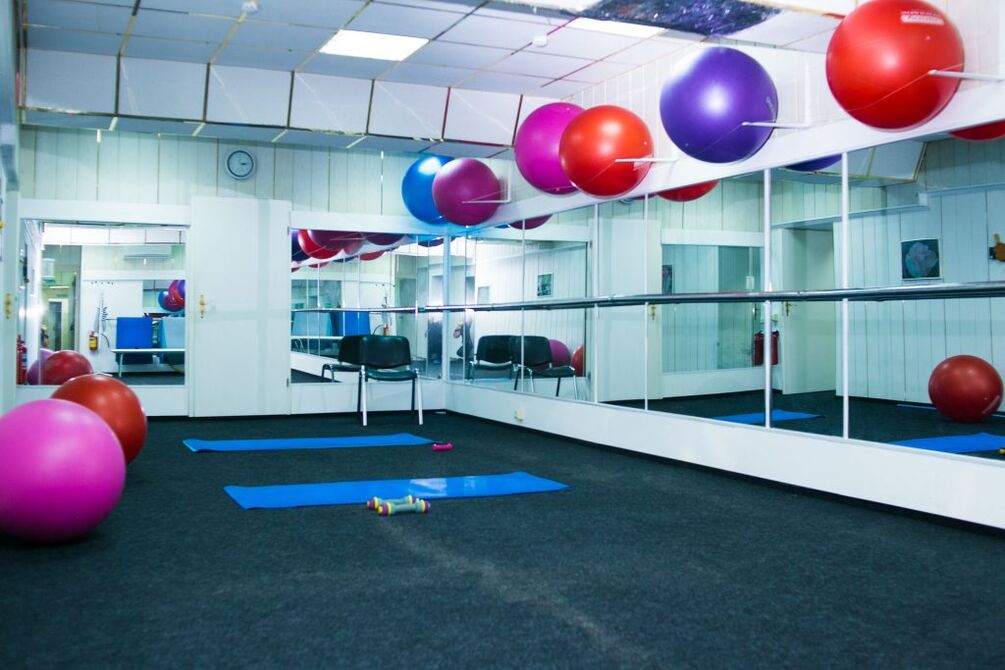
In the future, patients can practice therapy to exercise on their own home.At the same time, it is important to access it with complete responsibility, perform exercises slowly, without rushes and in comfortable conditions.But if pain occurs at any time during the exercise, you would immediately stop performing exercises that caused your appearance and addressed your doctor to determine the causes and correct the exercise therapy program for cervical osteochondrosis.
When you do exercise therapy, it is forbidden to make a sudden, strong movements, turn your head or perform exercises through pain.In such situations, there is a great risk of exacerbation of existing changes in discs instead of receiving the expected benefit.
Swimming has a very positive effect on the condition of the spine.It is exactly the such sport that does not include stress on discs, but actively involves the muscles back and neck.As a result, the muscle corset is effectively strengthened, acting as natural support spine.Therefore, if possible, they are advised to visit the pool 2-3 times a week.
Hand therapy for cervical osteochondrosis
Hand therapy is one of the most effective methods of cervical osteochondorosis, as it allows you to affect muscles and soft tissues, but also spine itself.But it is very important to take responsible access to chiropractors to choose from an incorrect or too strong influence can lead to the worsening of the patient, and even the development of complications.Such a specialist may not have only more medical education and a license for practical hand therapy, but also has a good understanding of the characteristics of anatomy and osteochondrose and have enough experience.
Do not confuse manual therapy and therapeutic massage.The differences between these hand therapy types are significant, as therapeutic massage includes only soft tissues, while during the hand therapy, the doctor is also working on spine.
Thus, any manual therapy session begins with a blow, which allows you to prepare the skin for more active effects.In the future, rubbing, mixing and squeezing techniques are used, which allows you to activate blood flow in the surrounding collar, neck and upper back.As soon as the skin and muscles are heated enough, and the patient is relaxed, the doctor begins to perform mobilizational and manipulation techniques.They include the implementation of turns with oscillatory movements, pushes in the direction of the fastest limit of movement, which leads to increased mobility of the spine and elimination of functional blocks.
So thanks to qualified manual therapy, it is possible:
- Normalize the position of vertebrae, which eliminates increased pressure on interverters and creating favorable conditions for their restoration;
- Eliminate pain caused by cervical osteochondrose and its complications;
- Bring excessively relaxed muscles in a normal tone and relax spasmodic muscles;
- Increase door mobility;
- Remove pressure on vertebrates and thus normalize blood flow to the brain;
- Remove the compression of spinal roots and thus normalize the implementation of bioelectric pulses to those inervation organs from which they are responsible, as well as reduce pain.
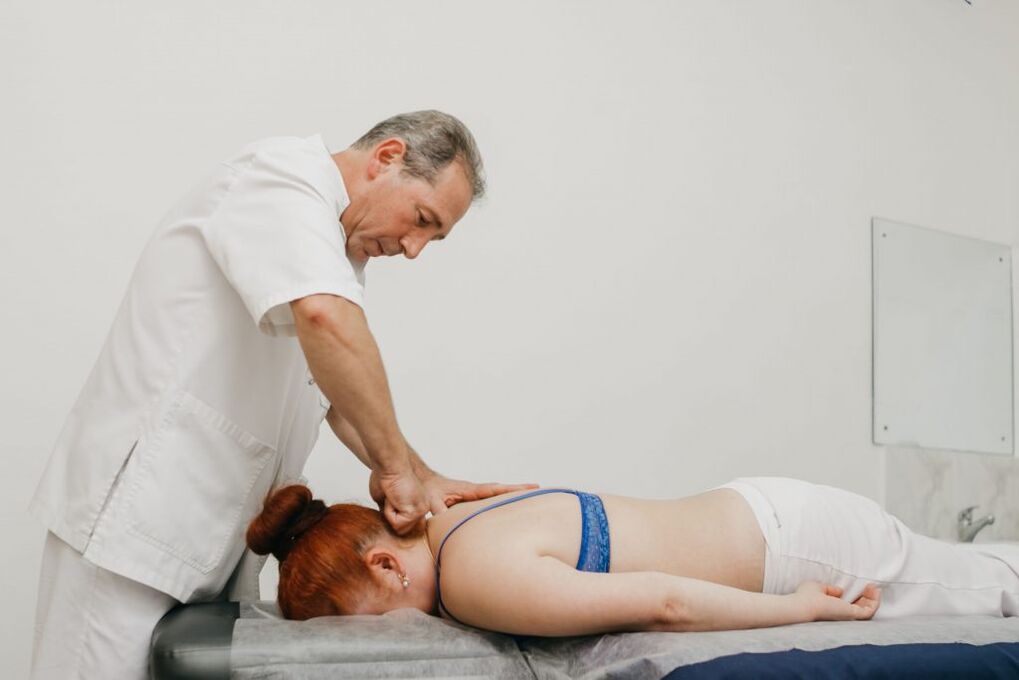
It is especially valuable to highlight the author's manual therapy method.This includes the use of special, patented influence techniques, which enables a pronounced result after 1. sessions, not only on the part of the door that affects osteochondrose, but also throughout the body.As a result, only pain and other symptoms of the disease do not disappear, but also the functioning of all bodies improves and the immune system is strengthened.Second and subsequent sessions improve the positive effect and combine it, which guarantees that other medical recommendations will be followed, the remission period will last as long as possible.
Self-massage
Improve their well-being, patients may periodically perform self-offerers to mitigate feelings of fatigue and pain reduction.To do this, sit into a comfortable position and try to relax your neck muscles.Then make movement movement with your palms, gradually moving to a circular rub, catching the shoulder area.All movements are performed from the spine without sudden and strong pressure.In this case, you can use local anti-inflammatory drugs recommended by your doctor.
Physiotherapy treatment
Physiotherapy is listed outside an acute inflammatory process.Allows you to consolidate achieved treatment scores and further improve the patient's condition.As a rule, the exchange rate of 10-15 proceedings was selected separately for each patient.It might be:
- Electrophoresis - includes the use of electricity to ensure deeper penetration of the indicated drugs.
- Magnetotherapy - helps activate blood circulation in the field of influence and encourage the flow of metabolic processes.In addition, magnetic therapy sessions have an analgesic effect and help to remove swelling.
- Laser therapy has an anti-inflammatory, vasodiling effect, leading to a reduction in pain weight.
- Ultrasonic therapy is the method of physiotherapy based on the positive effect of ultrasonic waves on the body.They help reduce the sensitivity of nerve endings and also have anti-inflammatory and analgesic effect.
- Diaglinamic currents - procedures lead to pain reductions, improve tissue nutrition, positively affects muscles and help removes inflammation.
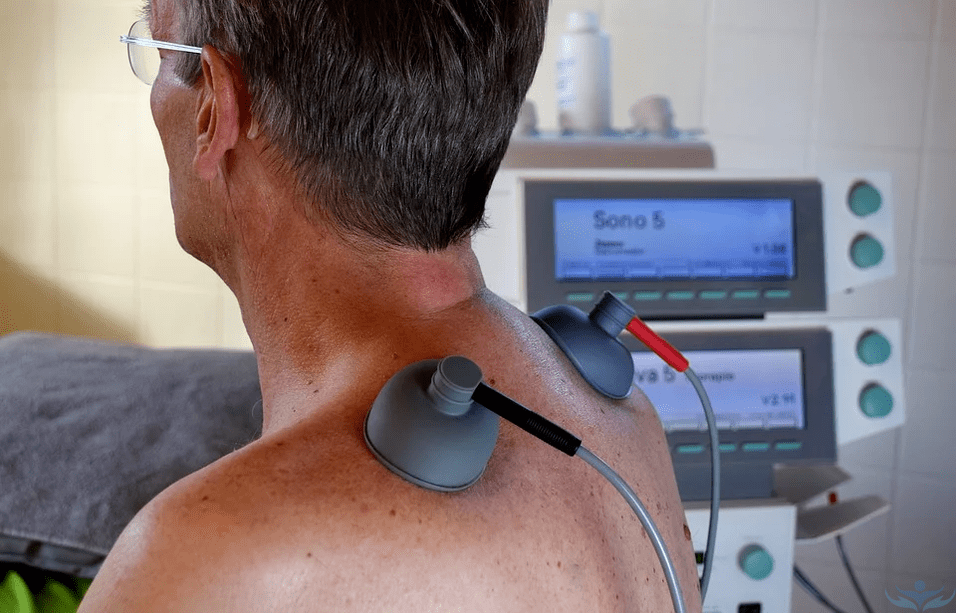
Traction therapy
When the vertebrae gather due to the flattening of interverters, the traction therapy is indicated by the Glisonton loop.The essence of the method is to apply the precision adjusted tension load on the Grlić Maril using a special device that corrects your head and has the load on the opposite side.Such actions help increase the distance between vertebral, which leads to a reduction in discs and creates favorable conditions for their recovery.But such therapy can only prescribe a doctor.
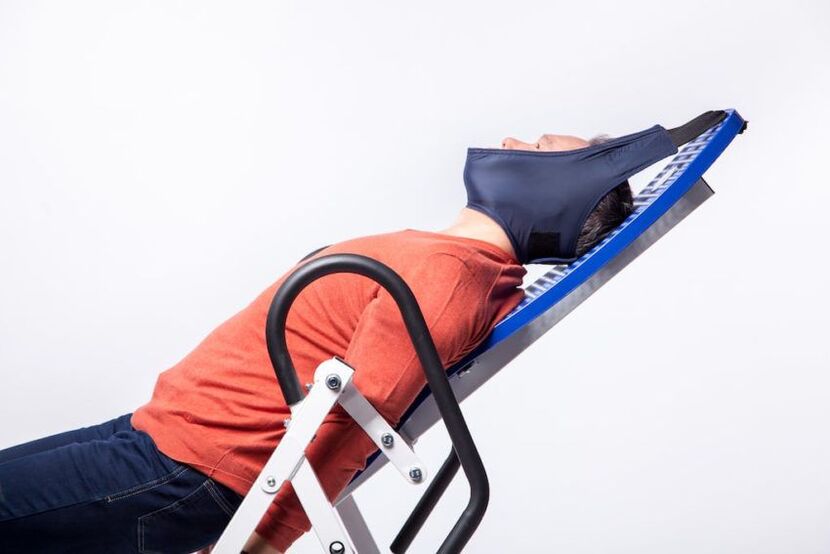
Needle applicator
A simple is simple, an affordable way of reflexology in the area area.This could be a plate with spikes that should be placed under the door or a similar device, but in the form of a roller.Thanks to the thorn thorns, skin recipers are irritated, leading to more active blood flow to the affected area.
Some patients recorded a reduction in neck pain after using applicators, as well as the increase in performance, improved sleep quality and restoration of the door mobility.But if you have skin lesions in the affected area or vascular diseases, you should not use the needle applicator.
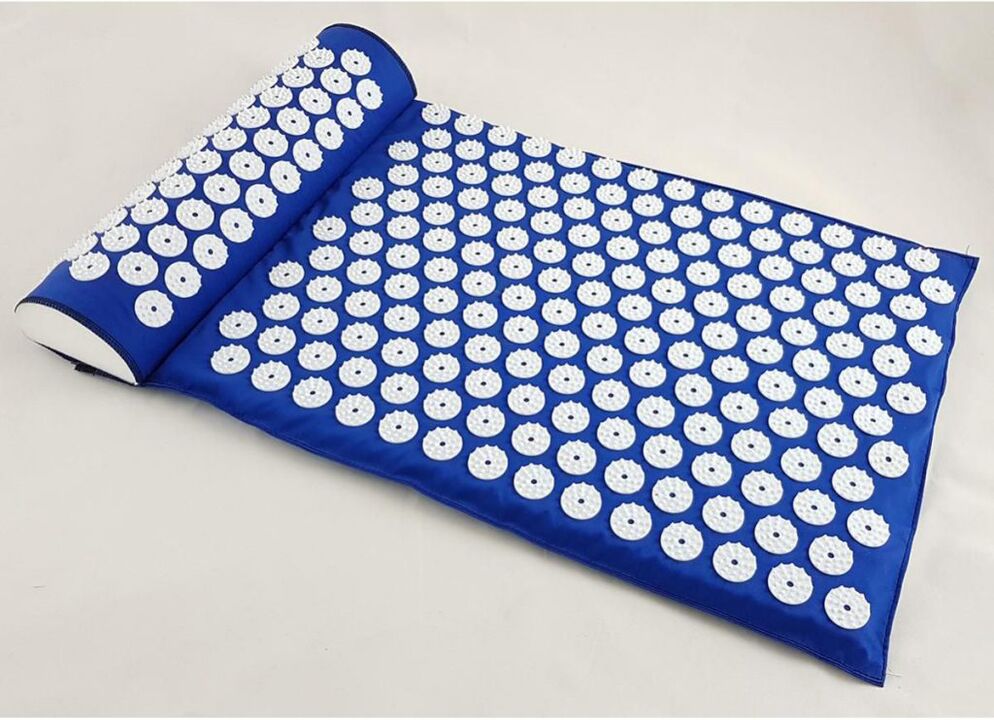
Orthopedic devices
In order to reduce the load on the neck spine, it is recommended to change the mattress and pillows on orthopedic, because sleeping on an uncomfortable cushion causes additional compression of rooky arteries and nerve troops during sleep.Orthopedic products are free of this shortage and ensure maintenance of a physiologically correct spine position along the entire length and thus reduce the speed of the existing osteochondrose.
But it is important to choose a real pillow and a mattress to suit individual patient characteristics and contain appropriate charging.Thanks to them, it is possible to improve the quality of sleep and wake up in the morning cheerful and rest.
Also, some patients for carrying collars with fists are recommended.It is a removable orthopedic device that allows you to repair your door and significantly reduce the load on the burnt spine, for example, when working on your computer or after suffering injury.The collar is placed before the expected load on the neck, but must be removed during sleep and rest.They differ in design, height, degree of fixation, so that only the present doctor can choose optimal.
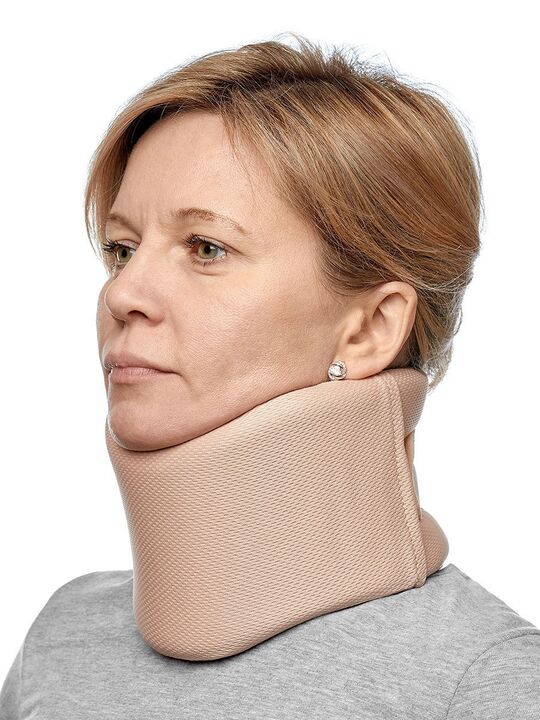
Therefore, the treatment of cervical osteochondorosis can be quite lengthy and complex.You need to be ready for this, because there is no other way to stop the development of changes in interfaced discs, avoid developing complications and needs for surgery.But in most cases the state of patients improves in the first weeks of treatment.At the same time, it is important not to self-date, but by contacting neurologists, as only a qualified specialist will be able to determine the degree of osteochondrose and choose the most appropriate treatment for a particular patient.

















































